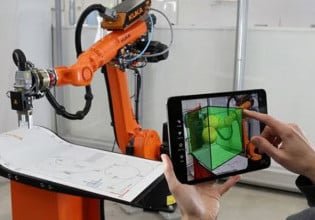Festo Expands its Controlled Pneumatics Techology
Festo has further developed their controlled pneumatics to create greater sustainability by reducing energy consumption, unnecessary use of compressed air, and extending equipment life.
Festo has continued to develop its controlled pneumatics technology in the hopes of creating a more sustainable future for manufacturing processes. The use of controlled compressed air presents many benefits for resource conservation and manufacturing efficiency. Festo believes that their technology will make control systems more energy efficient to help keep costs low for industrial pneumatics.
Their technology looks to improve several different areas of pneumatic control including:
-
digital pneumatics
-
lowering pneumatic pressure
-
predictive maintenance
-
wear prevention
-
reduced energy consumption

The Festo Motion Terminal VTEM 1 simplifies and digitizes pneumatics for robotics and automation. Image used courtesy of Festo
Digital Pneumatics
Festo has created the Festo Motion Terminal VTEM in order to digitize pneumatic control systems for robotics and automation. The digitalization is intended to greatly simplify pneumatic control. With the addition of the Festo Motion Terminal VTEM, over 50 individual components can be replaced within the control circuit. This is possible because their automation platform uses piezo technology and the Motion App to monitor the pneumatic operations.
Festo has used the technology for several different applications including the production of wafers and tires. They use a system of controlled pneumatics that operates using proportional technology, sensors, and control algorithms to form a control loop. This enables the systems to create closed loop control with a digital influence capable of communication for increased pneumatic valve control.
This application of new technology helps to improve standard pneumatics that are traditionally simplistic. The simplicity of pneumatics is one of its main benefits. With the addition of Festo technology to standard pneumatics, many new applications become possible for the use of pneumatics in the robotic and automation industry.
Using Festo’s Motion App, the Motion Terminal VTEM can control varying pressures. Image used courtesy of Festo
Reducing Energy Consumption
Controlled pneumatics can be used to reduce energy consumption, and Festo has found the energy savings to be a significant advantage to the use of their new technology. The idea is that less pressure equates to less energy needed to perform the same task. Compressed air takes energy to create, and the higher pressure systems require more air than lower pressure systems. For horizontal cylinder applications, energy savings of 60% were achieved and a minimum savings of 33% for compressed air usage.
Festo claims that the design of the flow controller also helps to reduce the risk of leaks within the pneumatics of the system. The controllers total energy consumption is less than a watt, so an energy savings of nearly 80% can be expected for users.
Predictive Maintenance and Wear Prevention
The control unit is available with the Motion App that is capable of detecting leaks and includes leakage diagnostics for the system. Leak detection allows for accurate predictive maintenance via pneumatic monitoring. It works by using diagnostic cycles and defined threshold values to pinpoint the location of the leak. The Festo Motion Terminal can close off the faulty air duct after a diagnosis in order to prevent further loss of compressed air. This helps to reduce unnecessary use of compressed air.
Festo’s piezo valve integration reduces abrasion to extend hardware life. Image used courtesy of Festo
The Piezo system has been used to prevent wear within different systems. A nitrogen purge system from Festo was used to keep oxygen from oxidizing electrical wafers in a wafer manufacturing plant. The flow controller, also known as the mass flow controller MFC, uses piezo technology. It comes with an integrated sensor for operation in its unique environment.
In addition, the piezo valve reduces the risk of contamination of the gas flow caused by particle abrasion in its design. It has been designed to reduce particle content that causes abrasion by up to five times the normal amount. With less abrasion the valves last longer and increase the expected service life of the valve—this leads to large savings over time with reduced maintenance and part costs.
Efficient Pneumatic Technology
Festo has put considerable effort into understanding and expanding the efficient use of pneumatic valves. Their technology looks to extend the service life of valves while at the same time reducing the energy necessary to operate pneumatics within automated systems. They hope their product will result in making pneumatics sustainable, resource-saving, and energy-efficient.








